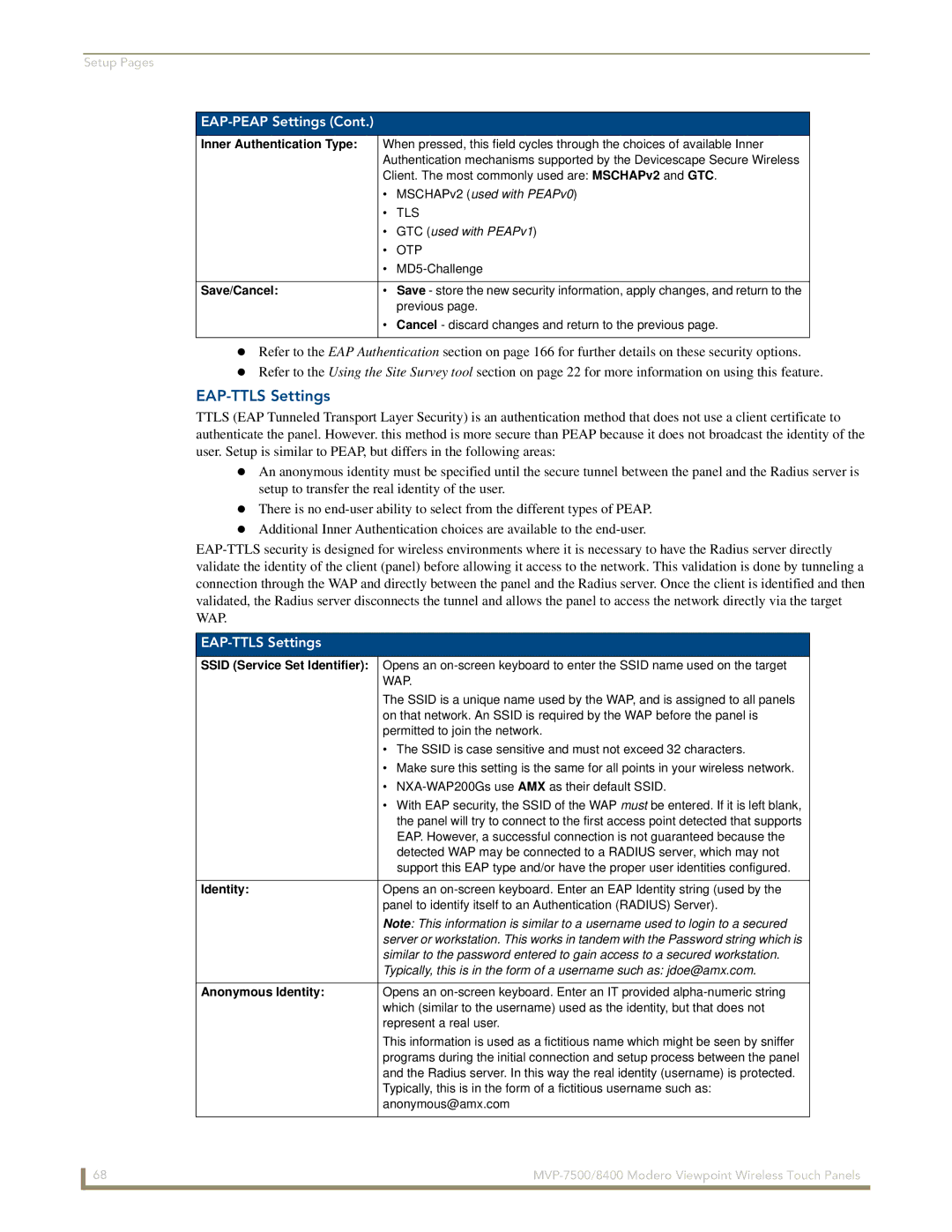
Setup Pages
EAP-PEAP Settings (Cont.)
Inner Authentication Type: | When pressed, this field cycles through the choices of available Inner | |
| Authentication mechanisms supported by the Devicescape Secure Wireless | |
| Client. The most commonly used are: MSCHAPv2 and GTC. | |
| • | MSCHAPv2 (used with PEAPv0) |
| • | TLS |
| • | GTC (used with PEAPv1) |
| • | OTP |
| • | |
|
|
|
Save/Cancel: | • | Save - store the new security information, apply changes, and return to the |
|
| previous page. |
| • Cancel - discard changes and return to the previous page. | |
|
|
|
Refer to the EAP Authentication section on page 166 for further details on these security options. Refer to the Using the Site Survey tool section on page 22 for more information on using this feature.
EAP-TTLS Settings
TTLS (EAP Tunneled Transport Layer Security) is an authentication method that does not use a client certificate to authenticate the panel. However. this method is more secure than PEAP because it does not broadcast the identity of the user. Setup is similar to PEAP, but differs in the following areas:
An anonymous identity must be specified until the secure tunnel between the panel and the Radius server is setup to transfer the real identity of the user.
There is no
|
|
|
|
|
|
|
|
|
|
|
| SSID (Service Set Identifier): | Opens an |
|
|
|
| WAP. |
|
|
|
| The SSID is a unique name used by the WAP, and is assigned to all panels |
|
|
|
| on that network. An SSID is required by the WAP before the panel is |
|
|
|
| permitted to join the network. |
|
|
|
| • The SSID is case sensitive and must not exceed 32 characters. |
|
|
|
| • Make sure this setting is the same for all points in your wireless network. |
|
|
|
| • |
|
|
|
| • With EAP security, the SSID of the WAP must be entered. If it is left blank, |
|
|
|
| the panel will try to connect to the first access point detected that supports |
|
|
|
| EAP. However, a successful connection is not guaranteed because the |
|
|
|
| detected WAP may be connected to a RADIUS server, which may not |
|
|
|
| support this EAP type and/or have the proper user identities configured. |
|
|
|
|
|
|
|
| Identity: | Opens an |
|
|
|
| panel to identify itself to an Authentication (RADIUS) Server). |
|
|
|
| Note: This information is similar to a username used to login to a secured |
|
|
|
| server or workstation. This works in tandem with the Password string which is |
|
|
|
| similar to the password entered to gain access to a secured workstation. |
|
|
|
| Typically, this is in the form of a username such as: jdoe@amx.com. |
|
|
|
|
|
|
|
| Anonymous Identity: | Opens an |
|
|
|
| which (similar to the username) used as the identity, but that does not |
|
|
|
| represent a real user. |
|
|
|
| This information is used as a fictitious name which might be seen by sniffer |
|
|
|
| programs during the initial connection and setup process between the panel |
|
|
|
| and the Radius server. In this way the real identity (username) is protected. |
|
|
|
| Typically, this is in the form of a fictitious username such as: |
|
|
|
| anonymous@amx.com |
|
| 68 |
|
|
|
|
| |||
|
| |||
|
|
|
|
|
